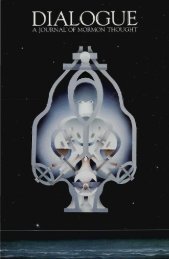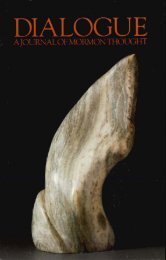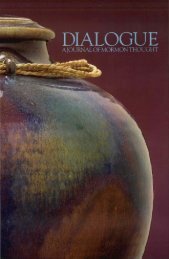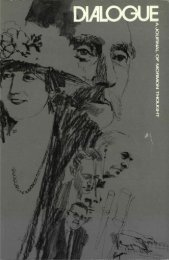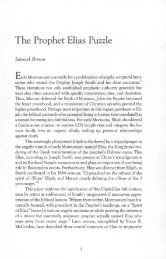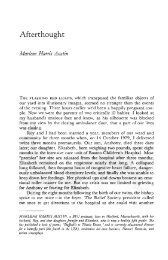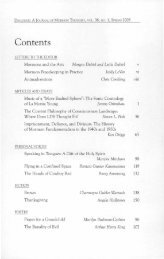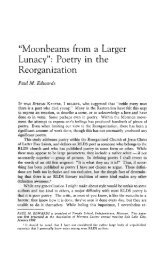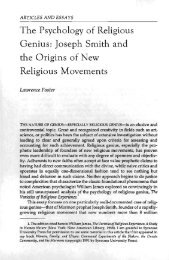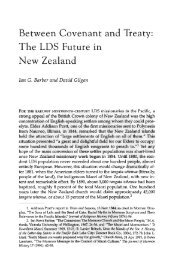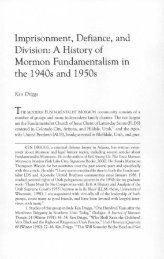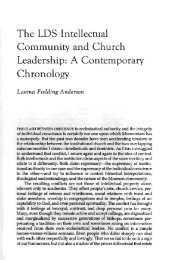Dialogue, Volume 25, Number 2 - Dialogue – A Journal of Mormon ...
Dialogue, Volume 25, Number 2 - Dialogue – A Journal of Mormon ...
Dialogue, Volume 25, Number 2 - Dialogue – A Journal of Mormon ...
You also want an ePaper? Increase the reach of your titles
YUMPU automatically turns print PDFs into web optimized ePapers that Google loves.
REVIEWS 171<br />
then goes on to catalogue some <strong>of</strong> the<br />
things she enjoys: "A new collapsible pair<br />
<strong>of</strong> glasses," the "Clean up window" on<br />
her new computer, "a young mare / and<br />
gelding frolicking like kittens," the sound<br />
<strong>of</strong> "the brook getting in with / the white<br />
swans at the black pond" (p. 66). The<br />
account <strong>of</strong> what pleases seems random<br />
and list-like — and those are qualities <strong>of</strong><br />
many <strong>of</strong> the poems —but that very randomness<br />
can be attributed to Thayne's<br />
great powers <strong>of</strong> observation and her appreciation<br />
for every aspect <strong>of</strong> life it is<br />
humanly possible to enjoy.<br />
The hopefulness <strong>of</strong> the poems is balanced<br />
by an awareness <strong>of</strong> mortality. Aging<br />
or death is the background <strong>of</strong> many <strong>of</strong><br />
the poems and the foreground <strong>of</strong> a few.<br />
But the eventuality <strong>of</strong> death serves, in fact,<br />
to make our human experiences all the<br />
more precious. As a whole, the poems <strong>of</strong><br />
this volume are an affirmation <strong>of</strong> life.<br />
They celebrate sensory pleasure, the small<br />
touching gesture, physical and emotional<br />
contact with others, moments <strong>of</strong> variety<br />
and beauty in the natural world, and<br />
allege again and again how much <strong>of</strong> experience<br />
can be relished. In final analysis,<br />
one can learn from these poems not<br />
merely how to survive but how to flourish.<br />
Unnatural History<br />
Refuge: An Unnatural History <strong>of</strong> Family<br />
and Place by Terry Tempest Williams (New<br />
York: Pantheon Books, 1991), 304 pp.,<br />
$21.<br />
Reviewed by Helen B. Cannon, a<br />
member <strong>of</strong> the English department at<br />
Utah State University, a freelance writer,<br />
and an editorial associate for DIALOGUE.<br />
SOMETIMES WHEN I GO to readings given<br />
by Nature writers, that new and popular<br />
set exploring their private, half-mystical<br />
genre, I think for a moment that I'm listening<br />
to LDS general conference talks —<br />
the histrionic intoning <strong>of</strong> truth on automatic<br />
pilot —the sincere, paternalistic,<br />
sing-song <strong>of</strong> lesson.<br />
In the first paragraph <strong>of</strong> Chapter 1 <strong>of</strong><br />
Terry Tempest Williams' Refuge, at first I<br />
thought I heard that familiar tone <strong>of</strong> sanctimony<br />
and awe, even when the words<br />
gave only geographic, not spiritual, directions:<br />
When I reach Foothill Drive, I turn right,<br />
pass the University <strong>of</strong> Utah, and make<br />
another right, heading east [sic] until I<br />
meet South Temple, which requires a lefthand<br />
turn. I arrive a few miles later at<br />
Eagle Gate, a bronze arch that spans State<br />
Street. I turn right once more. One block<br />
later, I turn left on North Temple and pass<br />
the <strong>Mormon</strong> Tabernacle on Temple Square.<br />
From here, I simply follow the gulls west,<br />
past the Salt Lake City International<br />
Airport.<br />
These direction-giving words (the bane<br />
<strong>of</strong> geographic dyslexics, <strong>of</strong> whom I am<br />
one) came to me as a reverential reading<br />
about spiritual landscape, where "redrocks<br />
. . . bleed" (Williams 1989, 16)<br />
when you cut them. Come on, Terry, I<br />
thought. This is too much "sense <strong>of</strong> place,"<br />
as Nature writers call their orienting-onearth<br />
penchant. This is too literal a cartography.<br />
But I was wrong. Refuge is unquestionably<br />
not a formulaic book. It is, rather, a<br />
book where the author, in spite <strong>of</strong> herself,<br />
transcends the camp genre <strong>of</strong> nature<br />
writing and, for the most part, moves<br />
beyond the distraction <strong>of</strong> language calling<br />
attention to itself. Oh, nature is there<br />
all right, once we get past Temple Square<br />
and the freeway —not nature tooth and<br />
claw, nor nature as fey or awesome, but<br />
nature closely observed, drawn with a fine<br />
artistic, scientific, and personal precision.<br />
No tricks. No sentimentalizing. No histrionics.<br />
Nature here is "bedrock," to use<br />
Williams' own choice <strong>of</strong> metaphor. "I<br />
could not separate the Bird Refuge from<br />
my family. . . . The landscape <strong>of</strong> my<br />
childhood and the landscape <strong>of</strong> my fam-



